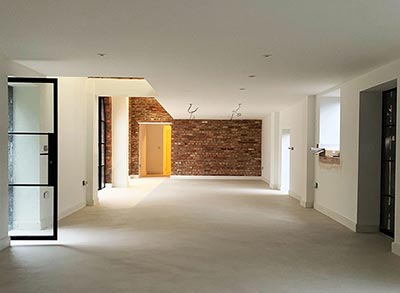
Microcement and micro-concrete might seem like one in the same thing, but it might surprise you to know that they’re both different solutions, with their own specific benefits and differences. In this article, we’ll be explaining what microcement and micro-concrete are, along with how they differ, so that you can decide which solution should be used when. So, what’s the difference between microcement and micro-concrete? Let’s take a closer look:
Microcement is a highly adhesive, thin and pliable coating that is composed of cement, mineral pigments and polymers. It’s usually applied to floors and walls, both internally and externally, in thin layers. Commonly, those layers are around 2-3mm, ensuring a seamless finish for minimalist and modern aesthetics. You might have also heard microcement referred to as: micro-toppings or micro-screeds. Microcement is also available in many different colours and finishes.
Here at Options 4 Surfaces, we have three microcement finishes on offer: rustic, natural and refined. We also have a complete and extensive colour range for you to choose from. This makes microcement the ideal solution for both domestic and commercial customers looking to elevate the look of their property, whether it be inside or out. No matter your taste or style, microcement is a popular wall and floor coating solution that will stand the test of time.
Micro-concrete is often mistaken for microcement. However, micro-concrete has a thicker application. Micro-concrete is designed for applications that require high levels of durability. Typically being applied in layers of up to 10mm thick, it’s often used for areas that experience heavy foot traffic or extreme weather conditions. More often than not, micro-concrete is used externally rather than internally. In addition, it’s normally chosen for commercial settings rather than domestic applications. This is because of its high resilience to impact and heavy wear.
One of the key differences between microcement and micro-concrete is the thickness at which it’s applied. Microcement is applied extremely thinly, around 2-3mm typically. Whereas micro-concrete is applied at a thickness of around 10mm. Another difference is that microcement can be used both internally and externally.
However, micro-concrete doesn’t have the same level of versatility. Micro-concrete is normally applied outdoors as it can better withstand harsh weather conditions, extensive wear and heavy impacts. Micro-concrete is far less flexible, making it more appropriate for straight edges and surfaces, such as walls and floors.
Microcement can be applied directly over a range of materials. It can also be used for covering both straight and curved edges and surfaces. Microcement is far more flexible and easier to work with. Despite their differences, however, both solutions offer a sleek and stylish finish to both internal and external applications. They’re both extremely versatile and hard-wearing. But microcement offers the most flexibility if you’re looking for a wall or floor finish that looks and feels great.
Options 4 Surfaces has a wide range of microcement solutions for internal and external applications. We have a range of finishes and colours available that will be guaranteed to breathe new life into your indoor or outdoor space, regardless of your taste and style. If you would like further information about our microcement walls and floors, or to learn more about our silicone rendering, then get in touch with a member of our friendly, professional team – we’re always pleased to hear from you.
Unit 1
Fletcher Street
Elan House
Long Eaton
Nottingham
NG10 1JU